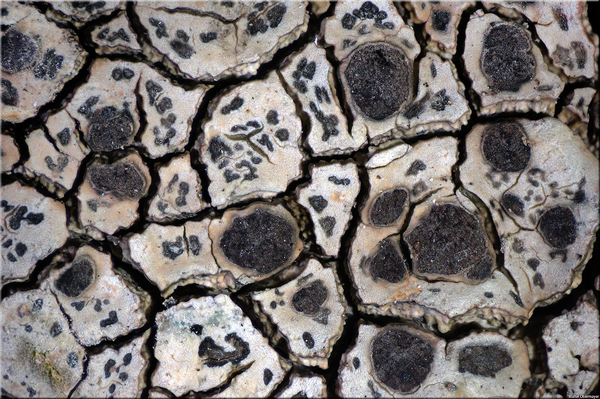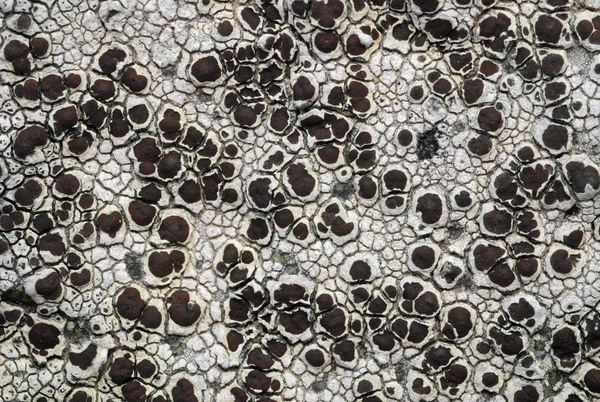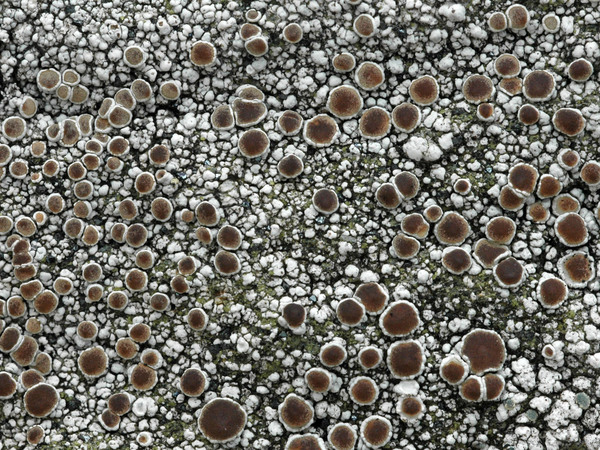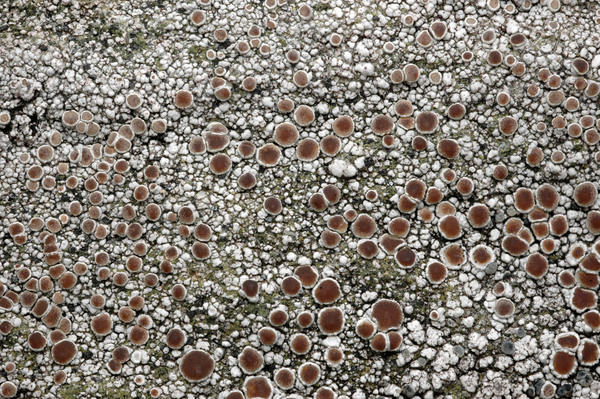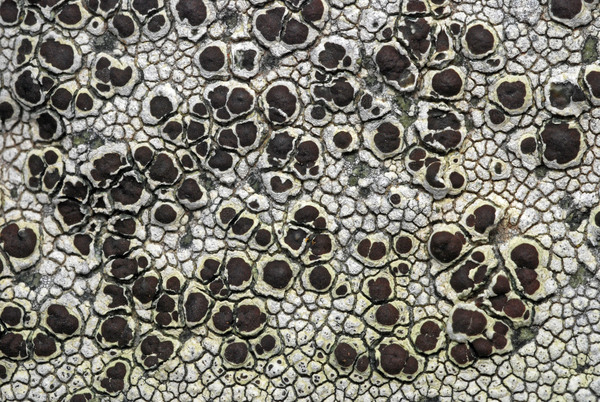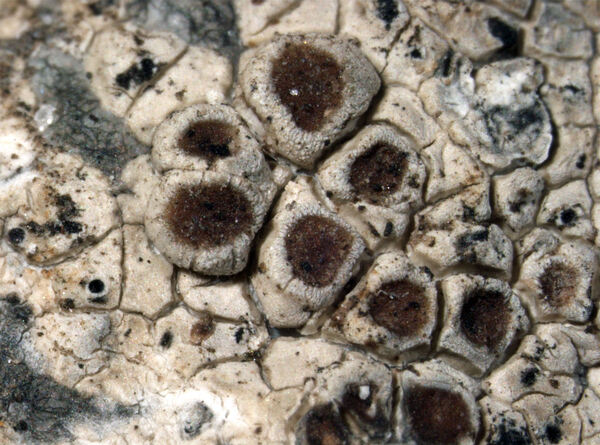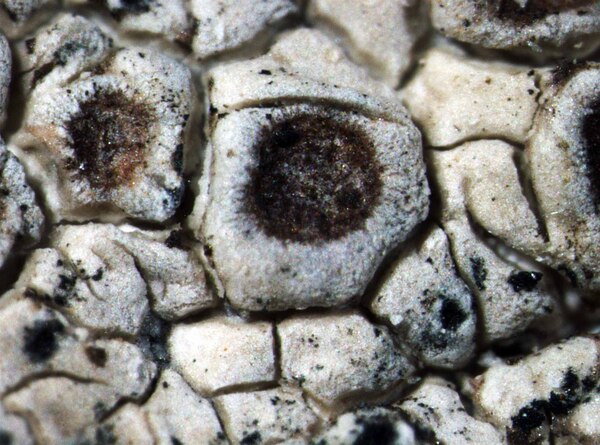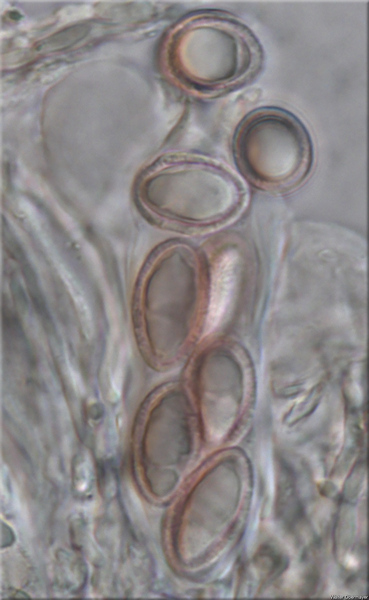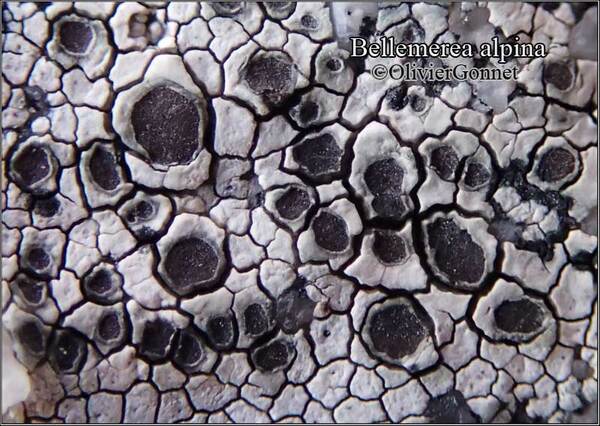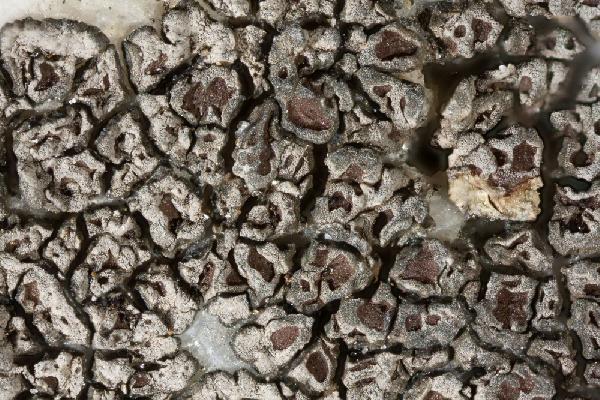Bellemerea alpina (Sommerf.) Clauzade & Cl. Roux
Bull. Soc. Bot. Centre-Ouest, n. sér. 15: 129, 1984. Basionym: Lecanora alpina Sommerf. - Suppl. Flor. Lappon.: 91, 1826.
Synonyms: Aspicilia alpina (Sommerf.) Arnold; Aspicilia cinereorufescens sensu Körb. non (Ach.) A. Massal.; Aspicilia cinereorufescens var. macrocarpa Anzi; Lecanora alpina var. sulphurata Th. Fr.
Description: Thallus crustose, episubstratic, rimose-areolate, rather thick, white to lead-grey or rarely pale brown, forming 1-5 cm wide, more or less orbicular patches or mosaics, sometimes delimited by a black prothallus. Areoles flat to convex, (0.2-)0.5-2(-3) mm wide, contiguous or rarely dispersed, usualy richly fertile, rarely sterile and with blue-grey marginal soralia. Cortex 10-30 µm thick, brownish in upper part, with a thin epinecral layer; medulla white, I+ blue. Apothecia aspicilioid, 0.2-1.5 mm across, immersed, 1-2(-4) per areole, round to weakly angular, with a concave to slightly convex, brown-red (when wet) or brown-black (when dry) disc, and a thin thalline margin. Proper exciple poorly developed, colourless, I+ blue; epithecium reddish brown to olive-brown, N-; hymenium colourless, 60-110 µm high, I+ blue; paraphyses branched and anastomosing in upper part, 2-2.5(-3) µm thick, the apical cells up to 4 µm wide, usually with a thin, dark brown cap; hypothecium colourless, 30-60 µm high, pale I+ blue, subtended by a discontinuous algal layer. Asci 8-spored, clavate, approaching the Porpidia-type, with a less distinct tube structure. Ascospores 1-celled, hyaline, ellipsoid or slightly fusiform, 8-15(-23) x 6-8(-13) µm, the inner wall I+ blue, with a thin halonate epispore, often of different sizes and shapes within the same ascus. Pycnidia dark, immersed. Conidia bacilliform, 4-6 x 1-1.5 µm. Photobiont chlorococcoid. Spot tests: thallus K+ yellow rapidly turning red (needle-like crystals), C-, KC-, P+ golden yellow. Chemistry: norstictic acid.
Growth form: Crustose
Substrata: rocks
Photobiont: green algae other than Trentepohlia
Reproductive strategy: mainly sexual
Commonnes-rarity: (info)
Alpine belt: rather common
Subalpine belt: rare
Montane belt: absent
Dry submediterranean belt: absent
Humid submediterranean belt: absent
Padanian area: absent
pH of the substrata:
1 2 3 4 5
Solar irradiation:
1 2 3 4 5
Aridity:
1 2 3 4 5
Eutrophication:
1 2 3 4 5
Poleotolerance:
0 1 2 3
Altitudinal distribution:
1 2 3 4 5 6
Rarity
absent
extremely rare
very rare
rare
rather rare
rather common
common
very common
extremely common
Loading data...
Occurrence data
Predictive map
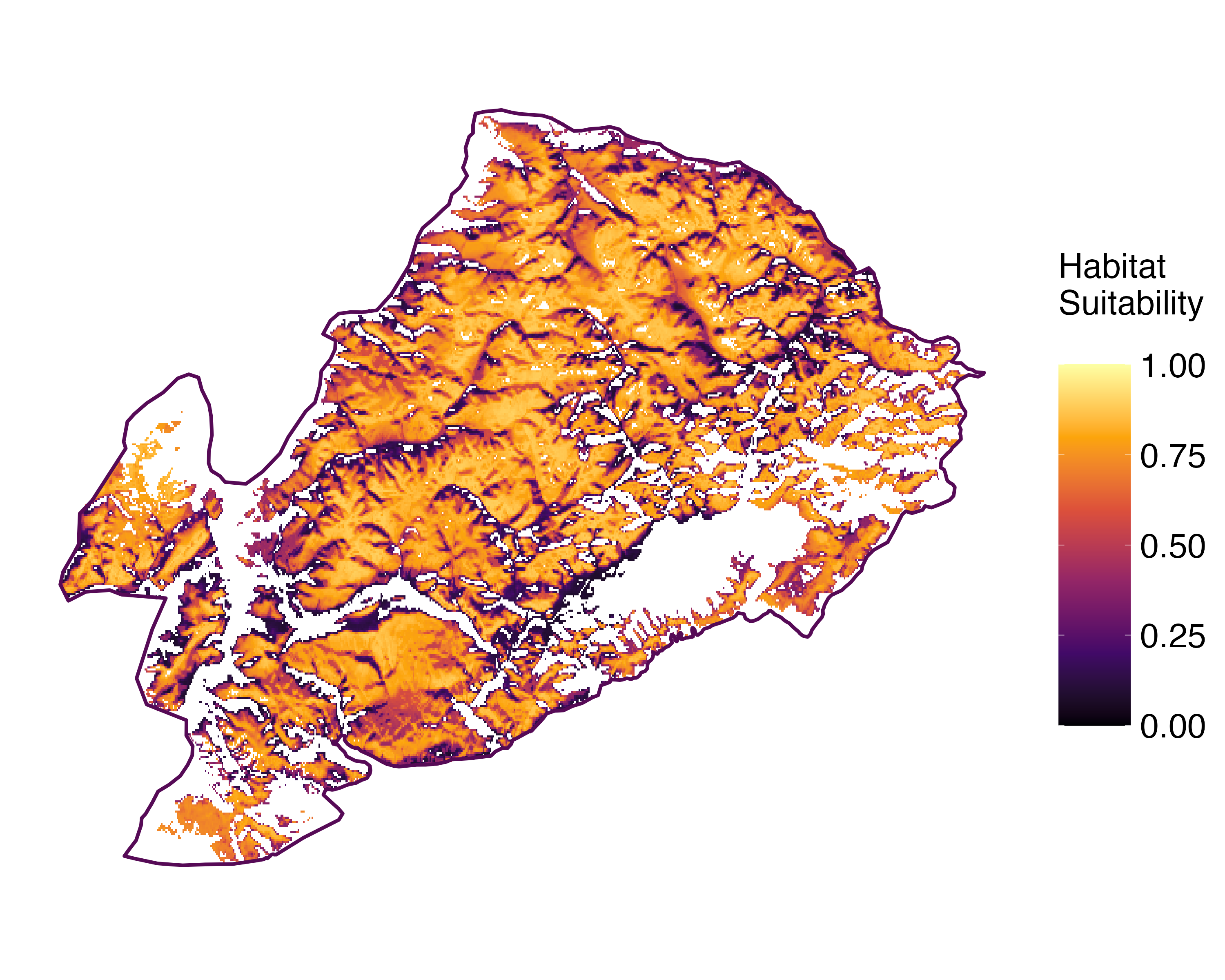 Current prediction (1981-2010)
Current prediction (1981-2010) Future prediction (2071-2100) SSP 1-2.6
Future prediction (2071-2100) SSP 1-2.6 Future prediction (2071-2100) SSP 5-8.5Predictive maps according to Francesconi et al. 2025
Future prediction (2071-2100) SSP 5-8.5Predictive maps according to Francesconi et al. 2025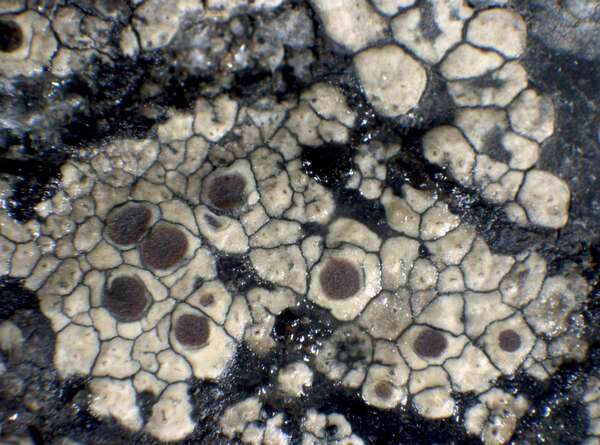
P.L. Nimis; Owner: Department of Life Sciences, University of Trieste
Herbarium: TSB (9456)
2001/11/22
wet thallus, apothecial disk reddish brown
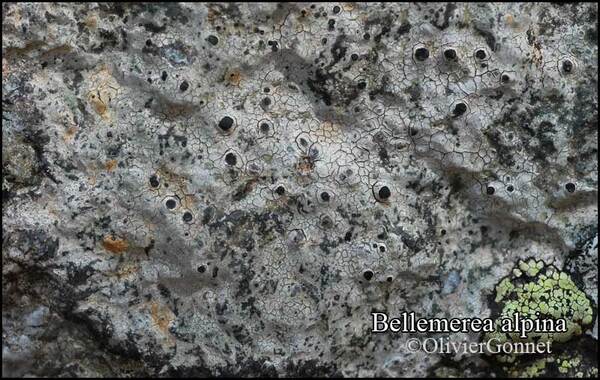
Courtesy: Olivier et Danièle Gonnet - Source: https://www.afl-lichenologie.fr/Photos_AFL/Photos_AFL_B/Bellemerea_alpina.htm
France, Haute-Savoie 2010
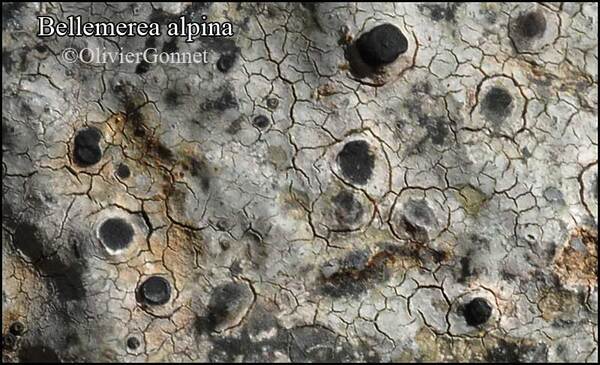
Courtesy: Olivier et Danièle Gonnet - Source: https://www.afl-lichenologie.fr/Photos_AFL/Photos_AFL_B/Bellemerea_alpina.htm
France, Haute-Savoie 2010
Growth form: Crustose
Substrata: rocks
Photobiont: green algae other than Trentepohlia
Reproductive strategy: mainly sexual
Commonnes-rarity: (info)
Alpine belt: rather common
Subalpine belt: rare
Montane belt: absent
Dry submediterranean belt: absent
Humid submediterranean belt: absent
Padanian area: absent
pH of the substrata:
| 1 | 2 | 3 | 4 | 5 |
Solar irradiation:
| 1 | 2 | 3 | 4 | 5 |
Aridity:
| 1 | 2 | 3 | 4 | 5 |
Eutrophication:
| 1 | 2 | 3 | 4 | 5 |
Poleotolerance:
| 0 | 1 | 2 | 3 |
Altitudinal distribution:
| 1 | 2 | 3 | 4 | 5 | 6 |
Rarity
absent
extremely rare
very rare
rare
rather rare
rather common
common
very common
extremely common
Loading data...
Occurrence data
Predictive map
 Current prediction (1981-2010)
Current prediction (1981-2010) Future prediction (2071-2100) SSP 1-2.6
Future prediction (2071-2100) SSP 1-2.6 Future prediction (2071-2100) SSP 5-8.5
Future prediction (2071-2100) SSP 5-8.5Predictive maps according to Francesconi et al. 2025

P.L. Nimis; Owner: Department of Life Sciences, University of Trieste
Herbarium: TSB (9456)
2001/11/22
wet thallus, apothecial disk reddish brown

Courtesy: Olivier et Danièle Gonnet - Source: https://www.afl-lichenologie.fr/Photos_AFL/Photos_AFL_B/Bellemerea_alpina.htm
France, Haute-Savoie 2010



